Empolese Territory - Valdelsa
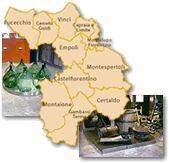
Through the centuries, in the hilly heart of the region, traversed by the Arno and Elsa river valleys, an economic district developed and distinguished itself on the Italian panorama for experimentation in agriculture and for glassmaking. The latter activity, in particular, sinks its roots into the Middle Ages and, to date, constitutes one of the most important centres of glass production nationally.
The centre of Colle Val d’Elsa, about 25 km from Siena, is the location of the interesting Museo del Cristallo which with historical exhibits and reconstructions illustrates the development of glassmaking in the Valdelsa and, in particular, in the little town of Colle Val d’Elsa.
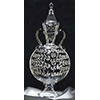
Founded in 2001, the Museum presents the history of crystal making in Colle di Val d’Elsa from the 19th century to the present. The largest section is dedicated to the glassmaking industry of Colle di Val d’Elsa from 1820, when the first furnace was built, to the manufacture of lead crystal in 1963. Also on show are glass exhibits from the 14th and 15th centuries which document the historical glassmaking activity in Valdelsa, in addition to objects carved with the age-old technique of the copper wheel. Quite noteworthy is the technological section where a traditional work environment - with the life-size cutaway reproduction of a furnace - stands alongside its modern automated counterpart. The Museum is housed in an underground space along with old glass and crystal shops.
(Stefania Mangia)
For a more detailed picture, we advise a visit to the permanent exhibition at Gambassi Terme which, with a more archaeological slant, presents the production of local glass with a brief introduction on glassmaking nationally, from antiquity to the 16th century. To reach Gambassi Terme some 30 km away, proceed northward on SS68 and then turn onto SP26.
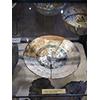
Born as a temporary exhibition in the ambit of the initiatives collateral to the conference, "The Production of Pre-industrial Glass in Gambassi and Valdelsa", it became a permanent exhibition in 1996, given its scientific interest and public response, while awaiting the foundation of a Glass Museum.
The exhibition is divided into various sections: glass production in Italy from protohistory up to the 16th century; pre-industrial glass technology with particular reference to raw materials, production facilities, tools and modelling objects in furnaces between the 13th and 16th centuries on the Gambassi territory; everyday life in the production areas of Gambassi between the 14th and 16th century. All the exhibits come from excavations conducted by the Archaeological Association of Florentine Valdelsa, in collaboration with the University of Siena and the Archaeological Survey of Tuscany.
The exhibition completes a project that includes itineraries on the territory, such as the archaeological park of Germagnana, with the reconstruction of a fourteenth-century glassmaking workshop, and the Centre for the Documentation of Technology and the production of pre-industrial glass in Valdelsa, which will be housed in the former theatre of Gambassi.
(Donato Monaco)
Taking SP64 for about fifteen kilometres, we come to the Meleto farm where, in the 19th century, the then-owner Cosimo Ridolfi opened an innovative agrarian institute.
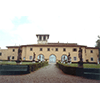
In 1827, president of the Accademia dei Georgofili Cosimo Ridolfi wrote in the «Giornale Agrario Toscano» that Tuscan farmers «quite often spend their sweat and efforts uselessly, because they are not always guided by the right criteria in their work». It was therefore necessary to train a class of technically qualified farmers capable of employing the new methods and new instruments to rationalise the production processes. One of the most significant initiatives in this direction was the creation of an institute of agricultural science at Ridolfi’s Meleto farm. Opened in 1834 and approvingly supported by the Georgofili, the school had a workshop for the construction of farming equipment and an experimental farm for practical-rural instruction. The study programme students had to follow was divided into three phases. The subjects of the first phase were drawing, geography, geology and botany; successively they studied geometry, mechanics and chemistry; finally, they followed courses of veterinary science, sheep-farming, the treatment of farm products and farm administration. The school initially registered eighteen students which soon rose to thirty.
From 1837 to 1853, the villa of Cosimo Ridolfi periodically hosted the famous "agrarian days". These were meetings between large, medium and small landowners. The delegations of numerous academies (Georgofili of Florence, Fisiocritici of Siena, Labronici of Livorno, etc.) took part in the meetings. New farm machines were presented, memorandums were read on the topics under discussion and shows were organised for the exchange of products. The meetings as well as the Meleto Institute itself were certainly the instrument for favouring innovation in agriculture, but they also had a "social" value, as they sought to maintain cohesion between Tuscan landowners, so as to guarantee the established order.
After nine years, the Institute ceased its activity with a positive balance. The experience continued at an agrarian science institute adjoining the University of Pisa, and in other schools inspired by the model Ridolfi proposed at his farm.
(Graziano Magrini)
To wind up our tour, the Museo della Vite e del Vino in Montespertoli that is reached by taking SS429 southbound and then turning onto SP4 towards Castelfiorentino, illustrates the importance of the territory’s current wine production.
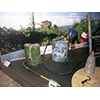
The Museum illustrates the various stages of producing wine: from harvesting the grapes, to vinification, to bottling. Enhanced by multimedia posts demonstrating the importance of this tradition for the local territory, the display consists of implements used in work and a series of photographs. Another part of the Museum is dedicated to a "laboratory of the senses",where visitors can taste wine while also perceiving its bouquet. The Centro per la Cultura del Vino "I Lecci" is made up of the Museum, a conference centre and a wine-cellar.
(Graziano Magrini)
****************************
Texts by Elena Fani
English translation by Victor Beard
Last update 12/gen/2008



 = libraries and archives
= libraries and archives  = scientific research centers
= scientific research centers  = memorial places of scientists
= memorial places of scientists = public health places
= public health places = places of science and worship
= places of science and worship = places of technology
= places of technology  = museums and collections
= museums and collections  = villas and gardens of science
= villas and gardens of science

